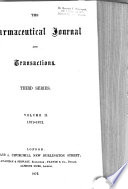 On partially liquefying carbonic acid by pressure alone, and gradually raising at the same time the temperature to 88° Fahr., the surface of demarcation between the liquid and gas became fainter, lost its curvature, and at last disappeared. The space... On partially liquefying carbonic acid by pressure alone, and gradually raising at the same time the temperature to 88° Fahr., the surface of demarcation between the liquid and gas became fainter, lost its curvature, and at last disappeared. The space...  Elements of chemistry: theoretical and practical - Page 329by William Allen Miller - 1863Full view Elements of chemistry: theoretical and practical - Page 329by William Allen Miller - 1863Full view - About this book
 | 1919 - 882 pages
...alone, and gradually raising at the same time the temperature to 88° F. (31° C.), the surface of demarcation between the liquid and gas became fainter,...slightly lowered, a peculiar appearance of moving or flickering striae throughout its entire mass. At temperatures above 88° F. no apparent liquefaction... | |
 | 1919 - 870 pages
...alone, and gradually raising at the same time the temperature to 88° F. (31° C.), the surface of demarcation between the liquid and gas became fainter,...slightly lowered, a peculiar appearance of moving or flickering striae throughout its entire mass. At temperatures above 88° F. no apparent liquefaction... | |
 | Thomas Edward Thorpe - 1922 - 760 pages
...between the liquid and gas became fainter, lost its curvature, and finally disappeared at 30-9°C. ' The space was then occupied by a homogeneous fluid which exhibited, when the pressure was suddenly diminiehed or the temperature slightly lowered, a peculiar appearance of moving or flickering striae... | |
 | Robert Martin Caven - 1927 - 272 pages
...pressure alone, and gradually raising at the same time the temperature to 31.1° C., the surface of demarcation between the liquid and gas became fainter,...slightly lowered, a peculiar appearance of moving or flickering striae throughout its entire mass. At temperatures above 31.1° C. no apparent liquefaction... | |
 | James Dewar - 1927 - 840 pages
...C. lost the sharp concave surface of demarcation between the liquid and the gas, the space being now occupied by a homogeneous fluid which exhibited, when...slightly lowered, a peculiar appearance of moving or flickering striae, due to great local alterations of density. At temperatures above 31° C. the separation... | |
 | Sir James Dewar - 1927 - 714 pages
...concave surface of demarcation between the liquid and gas and at last disappeared. The space was now occupied by a homogeneous fluid, which exhibited, when the pressure was suddenly diminished, or temperature slightly lowered, a peculiar appearance of moving or flickering striae throughout its entire... | |
 | Smithsonian Institution. Board of Regents - 1903 - 892 pages
...C. lost the sharp concave surface of demarcation between the liquid and the gas, the space being now occupied by a homogeneous fluid which exhibited, when...slightly lowered, a peculiar appearance of moving or flickering striae, due to great local alterations of density. At temperatures above 31° C. the separation... | |
 | Willett Lepley Hardin - 1899 - 272 pages
...the surface of demarkation between the liquid and gas became fainter, lost its curvature, and finally disappeared. The space was then occupied by a homogeneous...slightly lowered, a peculiar appearance of moving or flickering striae throughout the entire mass. At temperatures above 88° no apparent liquefaction of... | |
 | 844 pages
...C. lost the sharp concave surface of demarcation between the liquid and the gas, the space being now occupied by a homogeneous fluid which exhibited, when...slightly lowered, a peculiar appearance of moving or flickering striae, due to great local alterations of density. At temperatures above 31° C. the separation... | |
 | 1872 - 1104 pages
...disappears. The space is then occupied by a homogeneous fluid, which exhibits when the pressure is suddenly diminished or the temperature slightly lowered, a peculiar appearance of moving or tube when, after heating it considerably, the temperature is quickly lowered. This phenomenon was first... | |
| |